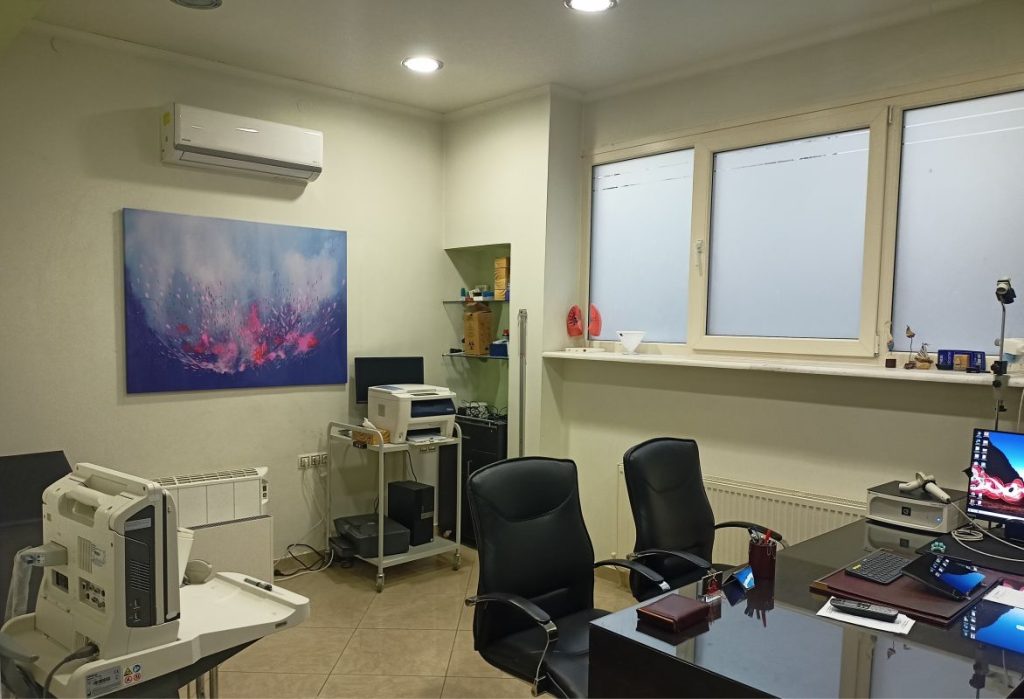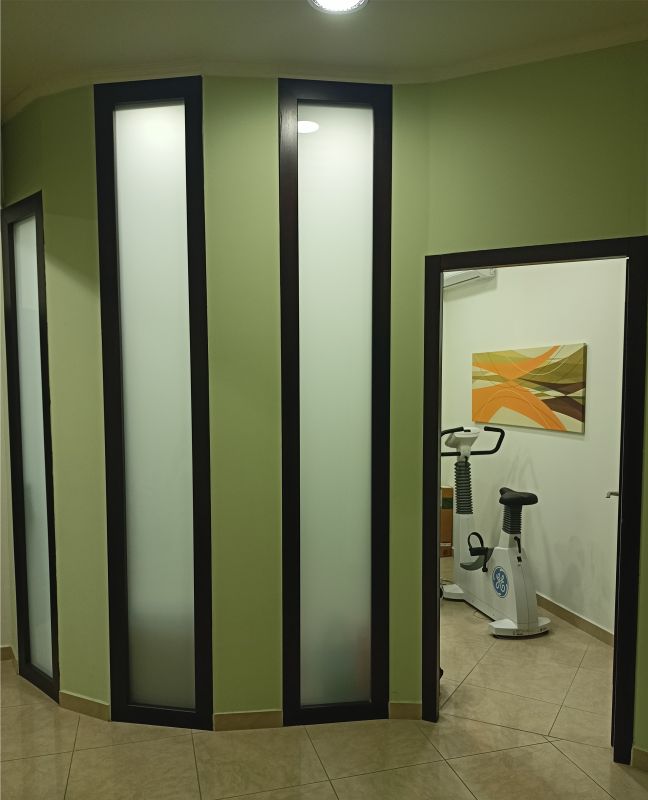



Pulmonary function test
Pulmonary function testing includes a wide range of tests that measure how well the lungs inhale and exhale air and how efficiently they carry oxygen to the blood.
The 3 main pulmonary function tests are spirometry, lung volume measurement, and diffusion capacity testing. Each of these tests provides different information about lung health and function and helps diagnose and monitor respiratory conditions.
Spirometry
It is a test to assess how well the lungs are working. You will be asked to breathe into a mouthpiece connected to an instrument called a spirometer. The spirometer measures the amount of air that the lungs inhale and exhale over a certain period of time. You may be asked to breathe normally or take a deep breath and exhale loudly.
The amount of air you exhale during a forced breath (called "forced expiratory volume" or FEV) and the total amount of air you exhale during the test (called "forced vital capacity" or FVC) are important measures to help to diagnose your condition to monitor your response to treatment.
Spirometry is particularly useful in evaluating obstructive lung diseases such as asthma and chronic obstructive pulmonary disease (COPD).
Your doctor will give you specific instructions to help you prepare for a spirometry test. These may include avoiding using your bronchodilator or inhaler for a period of time before the spirometer, avoiding alcohol and heavy meals or vigorous exercise a few hours before the test. Ideally, smoking is prohibited 24 hours before the test.
Lung volume measurement (plethysmography)
Plethysmography is a painless procedure that measures total lung capacity (how much air the lung can hold). This type of test is particularly useful in evaluating restrictive lung conditions, in which a person cannot inhale a normal volume of air. Restrictive lung disease can be caused by inflammation or scarring of the lung tissue or by abnormalities in the muscles or skeleton of the chest wall.
During plethysmography, you will sit in an airtight chamber, insert a breathing tube into your mouth, and breathe in and out a measured volume of air. A valve will then close the breathing tube and you will be asked to breathe against the resistance of the valve. This will cause your chest volume to increase, and this increase in chest volume will slightly decrease the volume in the airtight chamber. In turn, the pressure inside the box will change, and these changes will allow the total volume of your lungs to be determined.
To prepare for the plethysmography, wear comfortable clothing that will not restrict your breathing and avoid eating heavy meals for at least 3 hours before the test.
Diffusion capacity test (DLCO)
To determine how efficiently your lungs transfer oxygen from the air into your bloodstream, your doctor may perform a diffusing capacity test (also called DLCO, which stands for "diffusing capacity of the lung for carbon monoxide").
Diffusion capacity is measured when you breathe in carbon monoxide for a very short time, often only 1 breath. When you exhale, the concentration of carbon monoxide is measured. The difference in the amount you inhale and the amount you exhale allows your doctor to estimate how quickly the gas (oxygen) can travel from your lungs to your blood. Decreased diffusing capacity may indicate interstitial lung disease and fibrosis.
To prepare for the DLCO, avoid heavy meals for a few hours before the test and do not smoke for at least 4 hours before the test. Your doctor can also give you more specific instructions.
Cardiopulmonary exercise test (CPET)
Shortness of breath can be caused by reduced function of your lungs or heart. Advanced cardiopulmonary exercise testing (CPET) allows your doctor to make this distinction on the spot.
Your doctor may recommend a CPET for a number of reasons. For example, you may have a CPET as a precaution before surgery. If you have heart or lung disease, CPET can also help your doctor determine what level of exercise is right for you and whether you should use oxygen during exercise.
CPET measures how your lungs, heart and muscles respond to exercise. The tests can be carried out
Two of the most common cardiopulmonary exercise tests are the VO2 max test and the anaerobic threshold test. Abnormalities in your VO2 max and/or anaerobic threshold may indicate a condition such as COPD, ischemic heart disease, congestive heart failure, or pulmonary hypertension.
To prepare for a cardiopulmonary exercise test, avoid eating for 2 hours before the test, avoid drinking liquids for 1 hour before the test, and don't smoke for at least 8 hours before the test. You should wear comfortable clothes and shoes. Your doctor can also give you more specific instructions.
VO2 max test2
VO2 max (also called "oxygen uptake") refers to the maximum volume of oxygen you can metabolize during exercise. The higher your VO2 max, the more you can exercise. VO2 max is measured by exercising on a treadmill or stationary bike while breathing through a 2-way valve system. Air will enter through the room, but exit through sensors that measure oxygen volume and concentration. The intensity of your exercise will gradually increase by changing the speed or incline of the treadmill or the resistance on the bike. As the intensity of your workload increases, so does your oxygen consumption, until it reaches its peak. This peak is your VO2 max.
Anaerobic threshold test
Anaerobic threshold is the point at which your muscles use more oxygen than your heart and lungs can provide. When you reach this point, lactate begins to build up in your bloodstream. As with VO2 max, the higher your anaerobic threshold, the more you can exercise. Anaerobic threshold measurement involves taking blood samples (usually a thumb prick) during an exercise test while the intensity is progressively increased.
Oximetry studies
Oximetry is a painless and non-invasive method for measuring the amount of oxygen in the blood. It usually involves a clip placed on the ear or finger. The clip is attached to a device (the oximeter) that transmits a beam of light through the blood vessels and measures how much light is absorbed by oxygenated and deoxygenated blood.
A technologist may monitor your blood readings for several minutes while you sit to assess your oxygen levels at rest, without supplemental oxygen. Then, if necessary, supplemental oxygen may be given to bring your oxygenation to the level recommended by your doctor.
6min test, 6-minute walking test
Your doctor may also want to observe your oxygen levels in response to exercise. In this case, the doctor will ask you to walk with a clip oximetry sensor in place for 6 minutes. If your oxygen level drops, you may be asked to repeat the test with supplemental oxygen. This process can be repeated with increasing amounts of oxygen until your levels are adequate.
Nocturnal oximetry
Nocturnal oximetry is the measurement of blood oxygen levels during sleep. In some cases, this procedure can be done at home using a small, portable oximeter equipped with a memory module that can record a full night of oxygen and pulse data. Your doctor can use this information to help diagnose lung problems, sleep apnea, and other sleep-related disorders. Depending on the findings, you may be referred to a sleep disorder specialist.
Arterial blood gas with co-oximetry
An arterial blood gas is a common blood sample test that measures the levels of oxygen and carbon dioxide in the blood to determine how well your lungs are working. An arterial blood gas test uses blood taken from an artery, usually from the pulse site in the wrist. In addition to measuring the level of oxygen and carbon dioxide in your blood, this test will measure your blood's pH and bicarbonate levels. Abnormal values for oxygen, carbon dioxide, and pH may indicate changes in lung function, heart and circulatory function, kidney function, or other problems.
Co-oximetry measures the levels of compounds called carboxyhemoglobin and oxyhemoglobin in the blood. The purpose of co-oximetry is to detect oxygen deficiency at the tissue level (hypoxia). To perform this test, a painless co-oximeter clip will be placed on your finger and a beam of light will be transmitted through the blood.
Bronchial challenge test
The bronchial challenge test is used to assess the sensitivity of the airways in your lungs. In the first part of this procedure, you will have lung function tests (usually spirometry) to measure how much air and how fast you can breathe in and out. Next, you'll inhale a substance called metacholine, followed by a repeat of the lung function tests. The before and after results will be compared to determine what changes there are in your breathing.
You may be asked to stop using inhaled or oral medications for a period of time before the procedure. You may also be asked not to eat for 2 hours before the test.
Allergy tests
An allergy is an abnormal immune response to certain substances called allergens. Common allergy symptoms include congestion, wheezing, coughing, itching, sneezing, shortness of breath and runny nose. Allergies are linked to various respiratory diseases, including sinusitis and asthma.
A blood allergy test requires the collection of a small blood sample. The sample is exposed to an allergen and then measured for a specific antibody response. Allergy tests performed may include enzyme-linked immunosorbent assay (ELISA), in vitro basophil histamine release assay, and radioallergenic adsorbent test (RAST). The results of these tests may help your doctor determine the cause of your symptoms.

